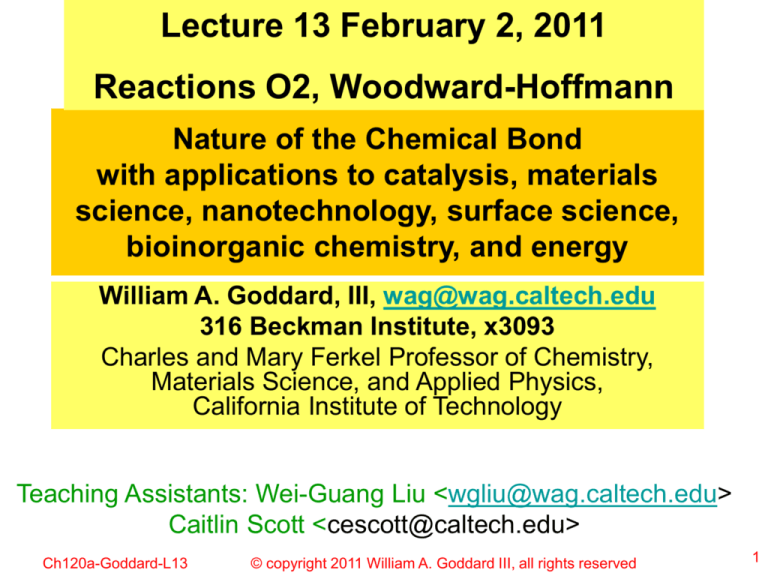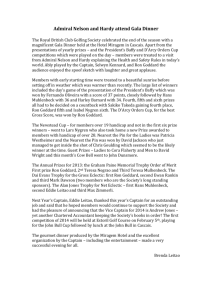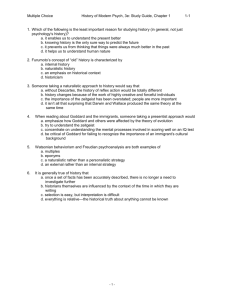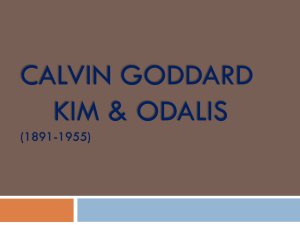
Lecture 13 February 2, 2011
Reactions O2, Woodward-Hoffmann
Nature of the Chemical Bond
with applications to catalysis, materials
science, nanotechnology, surface science,
bioinorganic chemistry, and energy
William A. Goddard, III, wag@wag.caltech.edu
316 Beckman Institute, x3093
Charles and Mary Ferkel Professor of Chemistry,
Materials Science, and Applied Physics,
California Institute of Technology
Teaching Assistants: Wei-Guang Liu <wgliu@wag.caltech.edu>
Caitlin Scott <cescott@caltech.edu>
Ch120a-Goddard-L13
© copyright 2011 William A. Goddard III, all rights reserved
1
Last time
Ch120a-Goddard-L13
© copyright 2011 William A. Goddard III, all rights reserved
2
The homonuclear diatomic correlation diagram
Mulliken knew the ordering of the atomic orbitals and
considered how combinations of the atomic orbitals
would change as the nuclei were pushed together to
eventually form a united atom.
Ch120a-Goddard-L13
© copyright 2011 William A. Goddard III, all rights reserved
3
Separated atom limit
MO notation
Ch120a-Goddard-L13
Separated atoms notation
© copyright 2011 William A. Goddard III, all rights reserved
4
Separated
atoms limit
Note that in
each case we
get one bonding
combination (no
new nodal
plane) and one
antibonding
combination
(new nodal
plane,
red lines)
Ch120a-Goddard-L13
© copyright 2011 William A. Goddard III, all rights reserved
5
At large R 2ps better bonding than 2pp
In earlier lectures we considered the strength of
one-electron bonds where we found that
Since the overlap of ps orbitals is obviously higher than pp
We expect that
bonding
antibonding
Ch120a-Goddard-L13
© copyright 2011 William A. Goddard III, all rights reserved
6
Summarizing united atom limit
Note for 3d, the splitting is
3ds < 3dp < 3dd
Same argument as for 2p
Ch120a-Goddard-L13
© copyright 2011 William A. Goddard III, all rights reserved
7
Correlation diagram for Carbon row homonuclear diatomics
C2 N O
2
2
United
atom
limit
Ch120a-Goddard-L13
F2
O2+ separated
+
N
2
© copyright 2011 William A. Goddard III, all rights reserved atom limit8
Homonuclear Diatomics Molecules – the valence bond view
Consider bonding two Ne atoms together
Clearly there will be repulsive interactions as the doubly
occupied orbitals on the left and right overlap, leading to
repulsive interactions and no bonding. In fact as we will
consider later, there is a weak attractive interaction
scaling as -C/R6, that leads to a bond of 0.05 kcal/mol,
but we ignore such weak interactions here
The symmetry of this state is 1Sg+
Ch120a-Goddard-L13
© copyright 2011 William A. Goddard III, all rights reserved
9
Halogen dimers
Next consider bonding of two F atoms. Each F has 3
possible configurations (It is a 2P state) leading to 9
possible configurations for F2. Of these only one leads
to strong chemical binding
This also leads to a 1Sg+ state.
Spectroscopic properties are
listed below .
Note that the bond
energy decreases for
Cl2 to Br2 to I2, but
increases from F2 to
Cl2. we will get back to
this later.
Ch120a-Goddard-L13
© copyright 2011 William A. Goddard III, all rights reserved
10
Di-oxygen or O2 molecule
Next consider bonding of two O atoms. Each O has 3 possible
configurations (It is a 3P state) leading to 9 possible
configurations for O2. Of these one leads to directly to a double
bond
This suggests that the
ground state of O2 is a
singlet state.
At first this seemed plausible, but by the late 1920’s Mulliken
established experimentally that the ground state of O2 is
actually a triplet state, which he had predicted on the basis of
molecular orbitial (MO) theory.
This was a fatal blow to VB theory, bringing MO theory to the
fore, so we will consider next how Mulliken was able to figure
thisCh120a-Goddard-L13
out in the 1920’s without
theWilliam
aid A.ofGoddard
computers.
© copyright 2011
III, all rights reserved
11
O2 MO configuration
2
For O2 the ordering of the MOs
4
Is unambiguous
2
(1pg)2
Next consider states of (1pg
)2
2
2
2
2
Ch120a-Goddard-L13
© copyright 2011 William A. Goddard III, all rights reserved
12
States arising from (p)2
Adding spin we get
MO theory
explains the triplet
ground state and
low lying singlets
O2
Energy
(eV)
1.636
(p)2
Ch120a-Goddard-L13
Ground state
© copyright 2011 William A. Goddard III, all rights reserved
0.982
0.0
13
States based on (p)2
skip
Have 4 spatial combinations
Which we combine as
where x and y denote
px and py
φ1, φ2 denote the
angle about the axis
and F is independent of φ1, φ2
Rotating about the axis by an angle g, these states transform as
DSS+
D+
Ch120a-Goddard-L13
© copyright 2011 William A. Goddard III, all rights reserved
14
Using the correleation diagram
In order to use the correlation
2
diagram to predict the states of
diatomic molecules, we need to
2
have some idea of what effective
4
R to use (actually it is the
effective overlap with large R
small S and small R large S).
Mulliken’s original analysis [Rev.
Mod. Phys. 4, 48 (1932)] was
roughly as follows.
1. N2 was known to be
nondegenerate and very strongly
bound with no low-lying excited
states
Ch120a-Goddard-L13
Choices for N2
2
4
4
2
2
2
2
2
© copyright 2011 William A. Goddard III, all rights reserved
15
N2 MO configurations
This is compatible with several
orderings of the MOs
Largest R
2
2
4
2
4
4
2
2
2
2
Smallest R
2
Ch120a-Goddard-L13
© copyright 2011 William A. Goddard III, all rights reserved
16
N2+
But the 13 electron molecules BeF, BO, CO+, CN, N2+
Have a ground state with 2S symmetry and a low lying 2S
sate.
In between these two 2S states is a 2P state with spin
orbital splitting that implies a p3 configuration
This implies that
Is the ground configuration for N2 and that the low lying
states of N2+ are
This agrees with
the observed
spectra
Ch120a-Goddard-L13
© copyright 2011 William A. Goddard III, all rights reserved
17
Correlation diagram for Carbon row homonuclear diatomics
C2 N O
2
2
United
atom
limit
Ch120a-Goddard-L13
F2
O2+ separated
+
N
18
2
© copyright 2011 William A. Goddard III, all rights reserved atom limit
1s and 2s cases
B
A
B
Ch120a-Goddard-L13
A
© copyright 2011 William A. Goddard III, all rights reserved
19
Bond
Anti
BO
1
2
2.5
3
2.5
2
1
Ch120a-Goddard-L13
0
© copyright 2011 William A. Goddard III, all rights reserved
20
More about O2
Ch120a-Goddard-L13
© copyright 2011 William A. Goddard III, all rights reserved
21
First excited configuration
(1pg)2
skip
Ground configuration
(1pu)3 (1pg)3 excited configuration
1S +
u
1D
(1pu)3 (1pg)3
u
3S u
Only dipole allowed
transition from 3Sg-
3S +
u
1S u
3D
u
Strong transitions (dipole allowed) DS=0 (spin)
- SSg
S
or
P
but
S
u
u
Ch120a-Goddard-L13
© copyright 2011 William A. Goddard III, all rights reserved
22
The states of O2 molecule
Moss and Goddard JCP 63, 3623 (1975)
(pu)3(pg)3
(pu)4(pg)2
Ch120a-Goddard-L13
© copyright 2011 William A. Goddard III, all rights reserved
23
Role of O2 in atmosphere
Moss and Goddard JCP 63, 3623 (1975)
Strong
Get 3P +
1D O atom
Weak
Get 3P +
3P O atom
Ch120a-Goddard-L13
© copyright 2011 William A. Goddard III, all rights reserved
24
Implications
UV light > 6 eV (l < 1240/6 = 207 nm) can dissociate O2 by
excitation of 3Su+ which dissociates to two O atom in 3P state
UV light > ~7.2 eV can dissociate O2 by excitation of 3Suwhich dissociates to one O atom in 3P state and one in 1D
(maximum is at ~8.6 eV, Schumann-Runge bands)
Net result is dissociation of O2 into O atoms
Ch120a-Goddard-L13
© copyright 2011 William A. Goddard III, all rights reserved
25
Regions of the
atmosphere
mesosphere
O + hn O+ + eHeats from light
stratopause
O + O2 O3
100
altitude (km)
O2 + hn O + O
O3 + hn O + O2
Heats from light
tropopause
50
stratosphere
30
20
10
troposphere
Heated from earth
200
Ch120a-Goddard-L13
300
© copyright 2011 William A. Goddard III, all rights reserved
26
ionosphere
night
Heaviside-Kennelly layer
Reflects radio waves to allow
long distance communications
D layer day
Ch120a-Goddard-L13
© copyright 2011 William A. Goddard III, all rights reserved
27
nightglow
At night the O atoms created
during the day can recombine to
form O2
The fastest rates are into the
Herzberg states, 3Su+ 1Su-
3D
u
Get emission at ~2.4 eV, 500 nm
Called the nightglow (~ 90 km)
Ch120a-Goddard-L13
© copyright 2011 William A. Goddard III, all rights reserved
28
Problem with MO description: dissociation
3S g
state: [(pgx)(pgy)+ (pgy) (pgx)]
As R∞ (pgx) (xL – xR) and (pgy) (yL – yR)
Get equal amounts of {xL yL and xR yR} and {xLyR and xR yL}
Ionic: [(O-)(O+)+ (O+)(O-)]
covalent: (O)(O)
But actually it should dissociate to neutral atoms
Ch120a-Goddard-L13
© copyright 2011 William A. Goddard III, all rights reserved
29
Back to valence bond (and GVB)
Four ways to combine two 3P states of O to form a s bond
bad
Closed shell
Open shell
Each doubly occupied orbital
overlaps a singly occupied
orbital, not so repulsive
Ch120a-Goddard-L13
Looks good because make p
bond as in ethene, BUT have
overlapping doubly occupied
orbitals antibonding
© copyright 2011 William A. Goddard III, all rights reserved
30
Analysis of open shell configurations
Each can be used to form a singlet state or a triplet state, e.g.
Singlet: A{(xL)2(yR)2[(yL)(xR) + (xR)(yL)](ab-ba)}
Triplet: A{(xL)2(yR)2[(yL)(xR) - (xR)(yL)](ab+ba)} and aa, bb
Since (yL) and (xR) are orthogonal, high spin is best (no
chance of two electrons at same point) as usual
Ch120a-Goddard-L13
© copyright 2011 William A. Goddard III, all rights reserved
31
VB description of O2
+
+
+
Must have resonance of two
VB configurations
Ch120a-Goddard-L13
© copyright 2011 William A. Goddard III, all rights reserved
32
Back to valence bond (and GVB)
Four ways to combine two 3P states of O to form a s bond
bad
Closed shell
Open shell
Each doubly occupied orbital
overlaps a singly occupied
orbital, not so repulsive
Ch120a-Goddard-L13
Looks good because make p
bond as in ethene, BUT have
overlapping doubly occupied
orbitals antibonding
© copyright 2011 William A. Goddard III, all rights reserved
33
New material
Ch120a-Goddard-L13
© copyright 2011 William A. Goddard III, all rights reserved
34
Bond energies
5.2 eV
Ch120a-Goddard-L13
© copyright 2011 William A. Goddard III, all rights reserved
35
Bond H to O2
Bring H toward px on Left O
Overlap doubly
occupied (pxL)2
thus repulsive
Overlap singly
occupied (pxL)2
thus bonding
Get HOO bond angle ~ 90º
S=1/2 (doublet)
Antisymmetric with respect to plane:
A” irreducible representation (Cs
group)
2A”
state
Ch120a-Goddard-L13
Bond weakened by ~ 51 kcal/mol
due
toA.loss
inIII,Oall2 rights
resonance
© copyright 2011
William
Goddard
reserved
36
Bond 2nd H to HO2 to form hydrogen peroxide
Bring H toward py on right O
Expect new HOO bond angle ~ 90º
Expect HOOH dihedral ~90º
Indeed H-S-S-H:
HSS = 91.3º and HSSH= 90.6º
But H-H overlap leads to steric effects for HOOH,
net result:
HOO opens up to ~94.8º
HOOH angle 111.5º
trans structure, 180º only 1.2 kcal/mol higher
Ch120a-Goddard-L13
© copyright 2011 William A. Goddard III, all rights reserved
37
Rotational barriers
7.6 kcal/mol Cis
barrier
HOOH
1.19 kcal/mol
Trans barrier
HSSH:
5.02 kcal/mol trans barrier
7.54 kcal/mol cis barrier
Ch120a-Goddard-L13
© copyright 2011 William A. Goddard III, all rights reserved
38
Compare bond energies (kcal/mol)
O2 3Sg-
119.0
50.8
HO-O
68.2
17.1
HO-OH
51.1
67.9
H-O2
HOO-H
51.5
85.2
Interpretation:
OO s bond = 51.1 kcal/mol
OO p bond = 119.0-51.1=67.9 kcal/mol (resonance)
Bonding H to O2 loses 50.8 kcal/mol of resonance
Bonding H to HO2 loses the other 17.1 kcal/mol of resonance
Intrinsic H-O bond is 85.2 + 17.1 =102.3
compare CH3O-H: HO bond is 105.1
Ch120a-Goddard-L13
© copyright 2011 William A. Goddard III, all rights reserved
39
Add material for O2 + C2H4 (sing and trip)
Ch120a-Goddard-L13
© copyright 2011 William A. Goddard III, all rights reserved
40
Bond O2 to O to form
ozone
Require two OO s bonds get
States with 4, 5, and 6 pp
electrons
Ground state is 4p case
Get S=0,1
but 0 better
Goddard
et al Acc. Chem. Res.
6, 368 (1973)
Ch120a-Goddard-L13
© copyright 2011 William A. Goddard III, all rights reserved
41
sigma GVB orbitals ozone
Ch120a-Goddard-L13
© copyright 2011 William A. Goddard III, all rights reserved
42
Pi GVB orbitals ozone
Some delocalization of central Opp pair
Ch120a-Goddard-L13
Increased overlap
between L and R Opp
due to central pair
© copyright 2011 William A. Goddard III, all rights reserved
43
Bond O2 to O to form ozone
lose O-O p resonance, 51 kcal/mol
New O-O s bond, 51 kcal/mol
Gain O-Op resonance,<17 kcal/mol,assume 2/3
New singlet coupling of pL and pR orbitals
Total splitting ~ 1 eV = 23 kcal/mol, assume ½
stabilizes singlet and ½ destabilizes triplet
Expect bond for singlet of 11 + 12 = 23 kcal/mol, exper = 25
Expect triplet state to be bound by 11-12 = -1 kcal/mol,
probably
between +2
and -2
Ch120a-Goddard-L13
© copyright
2011 William A. Goddard III, all rights reserved
44
Alternative view of bonding in ozone
Start here with 1-3 diradical
Transfer electron from central doubly
occupied pp pair to the R singly occupied
pp.
Now can form a p bond the L singly
occupied pp.
Hard to estimate
strength
of bond
Ch120a-Goddard-L13
© copyright 2011 William A. Goddard III, all rights reserved
45
Ring ozone
Form 3 OO sigma bonds, but pp pairs overlap
Analog: cis HOOH bond is 51.1-7.6=43.5
kcal/mol. Get total bond of 3*43.5=130.5 which
is 11.5 more stable than O2.
Correct for strain due to 60º bond angles = 26
kcal/mol from cyclopropane. Expect ring O3 to
be unstable with respect to O2 + O by ~14
kcal/mol,
But if formed it might be rather stable with
respect various chemical reactions.
Ab Initio Theoretical Results on the Stability of Cyclic Ozone
L. B. Harding and W. A. Goddard III
J. Chem. Phys. 67, 2377 (1977) CN 5599
Ch120a-Goddard-L13
© copyright 2011 William A. Goddard III, all rights reserved
46
Photochemical smog
High temperature combustion: N2 + O2 2NO
Thus Auto exhaust NO
2 NO + O2 2 NO2
NO2 + hn NO + O
O + O2 + M O 3 + M
O3 + NO NO2 + O2
Get equilibrium
Add in hydrocarbons
NO2 + O2 + HC + hn Me(C=O)-OO-NO2
peroxyacetylnitrate
Ch120a-Goddard-L13
© copyright 2011 William A. Goddard III, all rights reserved
47
More on N2
The elements N, P, As, Sb, and Bi all have an (ns)2(np)3
configuration, leading to a triple bond
Adding in the (ns) pairs, we show
the wavefunction as
This is the VB description of N2, P2, etc. The
optimum orbitals of N2 are shown on the next slide.
The MO description of N2 is
Which we can
draw as
Ch120a-Goddard-L13
© copyright 2011 William A. Goddard III, all rights reserved
48
GVB orbitals of N2
Re=1.10A
R=1.50A
R=2.10A
Ch120a-Goddard-L13
© copyright 2011 William A. Goddard III, all rights reserved
49
Hartree Fock
Orbitals N2
Ch120a-Goddard-L13
© copyright 2011 William A. Goddard III, all rights reserved
50
Ch120a-Goddard-L13
© copyright 2011 William A. Goddard III, all rights reserved
51
The configuration for C2
1
1
2
4
4
4
1
2
3
2
2
2
2
2
Ch120a-Goddard-L13
© copyright 2011 William A. Goddard III, all rights reserved
52
The configuration for C2
Si2 has this configuration
1
1
2
4
4
4
1
2
3
2
2
2
From 1930-1962 the 3Pu was
thought to be the ground
state
2
2
1S + is ground state
Ch120a-Goddard-L13
© copyright 2011 William A. Goddard III, all rights reserved
Now
53
Ground state of C2
MO configuration
Have two strong p bonds,
but sigma system looks just like Be2 which leads to a bond of ~ 1
kcal/mol
The lobe pair on each Be is activated to form the sigma bond.
The net result is no net contribution to bond from sigma
electrons. It is as if we started with HCCH and cut off the Hs
Ch120a-Goddard-L13
© copyright 2011 William A. Goddard III, all rights reserved
54
C2, Si2,
Ch120a-Goddard-L13
© copyright 2011 William A. Goddard III, all rights reserved
55
Ch120a-Goddard-L13
© copyright 2011 William A. Goddard III, all rights reserved
56
Low-lying states of C2
Ch120a-Goddard-L13
© copyright 2011 William A. Goddard III, all rights reserved
57
Ch120a-Goddard-L13
© copyright 2011 William A. Goddard III, all rights reserved
58
Ch120a-Goddard-L13
© copyright 2011 William A. Goddard III, all rights reserved
59
Include B2, Be2, Li2, Li2+
Ch120a-Goddard-L13
© copyright 2011 William A. Goddard III, all rights reserved
60
Re-examine the energy for H2+
For H2+ the VB wavefunctions were
Φg = (хL + хR) and
Φu = (хL - хR) (ignoring normalization)
where H = h + 1/R. This leads to the energy for the bonding state
eg = <L+R|H|L+R>/ <L+R|L+R> = 2 <L|H|L+R>/ 2<L|L+R>
= (hLL + hLR)/(1+S) + 1/R
And for the antibonding state
eu = (hLL - hLR)/(1-S) + 1/R
We find it convenient to rewrite as
eg = (hLL + 1/R) + t/(1+S)
eu = (hLL + 1/R) - t/(1-S)
where t = (hLR - ShLL) includes the terms that dominate the
bonding and antibonding character of these 2 states
Ch120a-Goddard-L13
© copyright 2011 William A. Goddard III, all rights reserved
61
The VB interference or resonance energy for H2+
The VB wavefunctions for H2+
Φg = (хL + хR) and Φu = (хL - хR) lead to
eg = (hLL + 1/R) + t/(1+S) ≡ ecl + Egx
eu = (hLL + 1/R) - t/(1-S) ≡ ecl + Eux
where t = (hLR - ShLL) is the VB interference
or resonance energy and
ecl = (hLL + 1/R) is the classical energy
As shown here the t dominates the bonding
and antibonding of these states
Ch120a-Goddard-L13
© copyright 2011 William A. Goddard III, all rights reserved
62
stop
Ch120a-Goddard-L13
© copyright 2011 William A. Goddard III, all rights reserved
63







